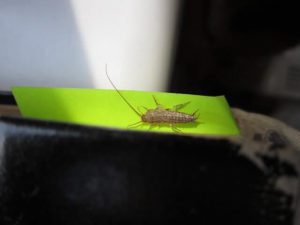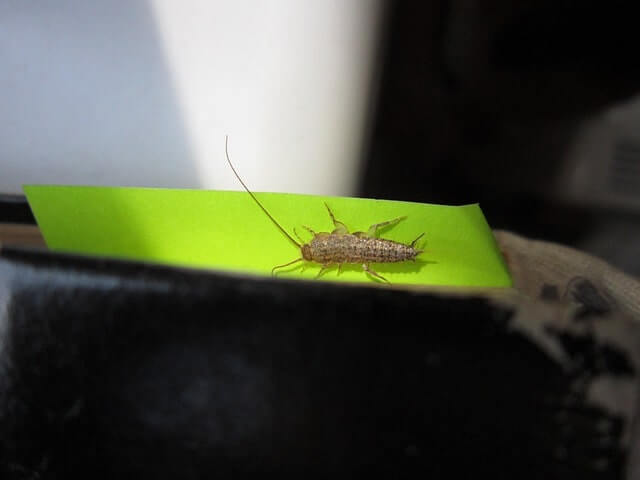Silverfish are not just creepy crawly insects that resemble a fish, with fish-like movements and even scales. These facts are true, but they are also more than just creepy, they can be destructive, consuming the craziest of materials, including clothes, carpet, book bindings, paper, and photos, to name a few.
Read on to learn of more things silverfish eat, their habits and life span, how we perform silverfish control, and 6 things you can do to prevent silverfish. If you need immediate assistance with pest control, give our office a call at 651-342-9489.
Table of Contents
- Silverfish
- Mating ritual
- Destructive pests
- 6 things you can do to prevent silverfish
- How we treat silverfish – silverfish control
- Conclusion & next steps
Silverfish
Silverfish got their name due to their color, shape, and habitual fish-like movements (wiggles). They also have scales that they can leave, indicating places they’ve been.
Silverfish are actually born white color, but they develop the grayish tint as they age, and they grow to be between ½ an inch and 1 inch in length. So, if you see a lighter gray silverfish, it is younger; or if you see a darker gray silverfish, it is older.
These pests are nocturnal, and as a result they really don’t like light. This tip can help you understand their habits, so if you take a flashlight around your house, any silverfish will scatter.
Silverfish have 3 protruding ligaments from its abdomen. The 2 on the side are called cerci and the 1 at the tip is called terminal filament. They have 2 antennae protruding from the sides of its head, and 6 legs on its thorax.
 A fascinating fact about silverfish is that if one of its cerci, terminal filament, or antennae is removed, it can regenerate that body part between 2 and 4 weeks.
A fascinating fact about silverfish is that if one of its cerci, terminal filament, or antennae is removed, it can regenerate that body part between 2 and 4 weeks.
Silverfish have compound eyes, like centipedes, compared to other similar arthropods that go eye-less.
If you have silverfish, do not consider them a seasonal pest, as a normal silverfish lives for 3 years or more!
Since they need humidity levels of 75% to 95%, they can be found in moist areas like basements and bathrooms, but have been known to explore dryer areas like bookshelves and storage areas. But they can roam dryer areas and circle back to drains or other damp places to get their fill of water.
While there are roughly 10 species of silverfish in North America, there is only 1 species of firebrat, the silverfish’s close relative.
A fascinating fact about silverfish is that if one of its cerci, terminal filament, or antennae is removed, it can regenerate that body part between 2 and 4 weeks.
Mating Ritual
Like the pavement ant or carpenter ant that participates in the nuptial flight prior to mating, silverfish too have a mating ritual.
Their extensive mating ritual has 3 phases, with each lasting about 1 hour.
The first phase consists of the male and female standing face to face and touching each other’s trembling antennae. They back up and regain composure face to face, touching antennae, over and over again.
The second phase is simpler: the male just runs away and the female chases him.
In the third phase the male and female stand side by side, head to head, toe to toe, as if sizing each other up. The male vibrates his tail, or terminal filament, against the female’s body.
After vibrating a while, the male deposits a spermatophore, which is a small, sperm capsule, near the female’s ovipositor, where she fertilizes her eggs.
Females lay less than 100 eggs in their lifetime, laying about 60 eggs the first time, and the rest a second time. She deposits the eggs in cracks and crevices where they only need 2 weeks to 2 months to hatch.
Silverfish go through 17 to 66 molts in their lifetime, and though they are born white, they develop the silver shades as they molt.
If you have silverfish, do not consider them a seasonal pest, as a normal silverfish lives for 3 years or more!
Destructive Pests
Silverfish can be very destructive pests, consuming a variety of materials. Though they can digest cellulose and sugar as a normal diet, they also consume starches and dextrin (used in adhesives).
Their trails of destruction lead to partly consumed book bindings, carpet fragments, tapestries, clothing, linen, and silk. They eat coffee, cotton, and dead insects.
Clearly their diet is extensive, considering they also eat dandruff, glue, hair, paper, photos, and even some paints and plasters.
If you have crumbs, they will eat those too. They will often eat their own dead skin (molted exoskeleton).
If they aren’t finding enough to eat, they will consume synthetic fabrics and leather. Certain types of crickets and clothing moths can be destructive too, so if you only see the damage, but not the pest, consult a pest control professional today for a thorough inspection! 651-342-9489.
Don’t think you can possibly try to starve them out, as they are resilient, lasting for more than a year without eating as long as water is available.
But don’t worry, earwigs, house centipedes, and spiders hunt and eat silverfish.
6 Things You Can Do to Prevent Silverfish
Because silverfish basically eat wherever they go (an exaggeration, but their diet is so extensive!), be on the lookout for their consumption trail. If you find pages of books with bite holes in them, you most likely have a silverfish problem. Silverfish often leave behind yellow stains, scales, and feces.
Knowing what to look for can help you determine what pest issue you have and how best to proceed with treatment.
But, also make sure you have the right pest. Firebrats and jumping bristletails are often confused as silverfish.
Read on to learn of 6 things you can do to prevent silverfish:
- Inspect your space. They either came in to your home on infected items or came from the outside.
- Since they crave high humidity areas, a simple option to eliminate these pests is to set up a dehumidifier.
- Repair any leaky or damaged pipes that could add moisture to your wall voids.
- Keep any flour, sugar, and oats in sealed containers.
- Store any old books, magazines, or other materials away from areas to which silverfish gravitate.
- Use Japanese cedar essential oil to ward them off.
How We Treat Silverfish – Silverfish Control
Our interior one-time crawling insect treatment consists of a full inspection of the areas you are seeing them, as well as inspection of other common areas where silverfish are found.
Inspection is important, but identification is even more important. Because silverfish can be confused with firebrats, they can easily be mistreated. Firebrats and silverfish appear similar, but have subtle differences. But if a silverfish issue is misidentified as a firebrat issue, the wrong areas will be treated. While silverfish prefer moist conditions, firebrats prefer dry conditions.
Pest Management Professionals magazine also suggests an exterior inspection to note if they have come in from the outside.
Our expert technicians will explain their treatment method to you, based upon what they’ve found in their inspections. Typically a treatment of those areas with a crawling insect insecticide is prescribed. And though a follow-up isn’t included, depending on your specific needs one may be added. In the result of any follow-up visits, no additional charges are applied to your service.
Our one-time service comes with a 2 month warranty, so once the technicians depart, if you find any new silverfish activity, give us a call.
Fun fact, because silverfish often roam throughout the night, they can be treated in a similar way cockroaches are treated in moist conditions.
If you have other crawling insect issues that need more extensive treatment, we can treat the exterior of your home and then the 2 month warranty extends to the exterior of your home, too!
Finally, if you have concerns with springtails invading your home annually, or if you have a couple of other pest concerns, be it yellow jackets, mice, or carpenter ants, we have you covered.
Our Peak Seasons Plan, includes 3 exterior sprays seasonally, and interior treatment too, preventing any crawling, jumping, flying, or stinging insects from entering your home. Rodent control is included as well.
Learn more about our Peak Seasons Plan, by reading our article on how to know if it’s for you, which explains the package in depth and answers some frequently asked questions.
As always, we would love to talk all of your issues through with you over the phone, so give us a call or text! 651-342-9489.
Silverfish are common crawling insects, some of the creepiest. For additional tips and tricks regarding crawling insects, check out our category within our blog.
Conclusion & Next Steps
You’ve learned quite a bit about how silverfish operate. You learned about their birth as white eggs that molt between 17 and 66 times turning into gray or silver insects. Silverfish have extensive eating habits and mating rituals, which you learned throughout.
Finally, you learned of 6 things you can do to prevent silverfish in your home and how Done Right Pest Solutions performs silverfish control.
Ultimately, we want you to feel safe and comfortable in your own home, but you can’t feel comfortable with insects eating your books and photos.
Give us a call today for all of your silverfish control needs. We have the highest customer service and quality of pest control service that comes with a warranty! 651-342-9489.
We can’t wait to help!
Done Right Team
Have you ever had a silverfish infestation? How did you find out and did you have to replace a lot of your belongings? We would love to hear from you below.
Did you find this article helpful? Consider subscribing to our free email newsletter, which offers a targeted approach to things you want help with.


Pingback: 12 DIY Tips For Earwig Control | Done Right Pest Solutions